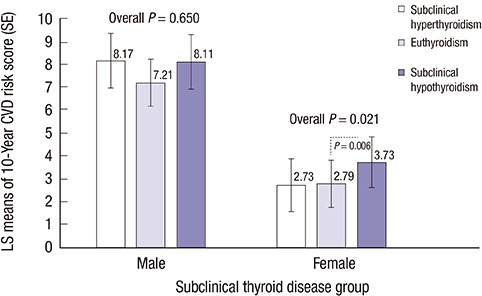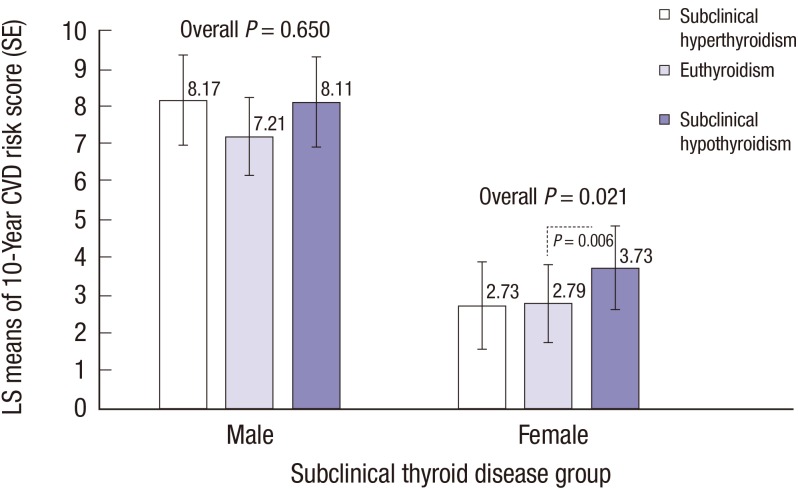1. Canaris GJ, Manowitz NR, Mayor G, Ridgway EC. The Colorado thyroid disease prevalence study. Arch Intern Med. 2000; 160:526–534. PMID:
10695693.
2. Biondi B, Bartalena L, Cooper DS, Hegedüs L, Laurberg P, Kahaly GJ. The 2015 European Thyroid Association guidelines on diagnosis and treatment of endogenous subclinical hyperthyroidism. Eur Thyroid J. 2015; 4:149–163. PMID:
26558232.
3. Hak AE, Pols HA, Visser TJ, Drexhage HA, Hofman A, Witteman JC. Subclinical hypothyroidism is an independent risk factor for atherosclerosis and myocardial infarction in elderly women: the Rotterdam Study. Ann Intern Med. 2000; 132:270–278. PMID:
10681281.
4. Ochs N, Auer R, Bauer DC, Nanchen D, Gussekloo J, Cornuz J, Rodondi N. Meta-analysis: subclinical thyroid dysfunction and the risk for coronary heart disease and mortality. Ann Intern Med. 2008; 148:832–845. PMID:
18490668.
5. Hueston WJ, Pearson WS. Subclinical hypothyroidism and the risk of hypercholesterolemia. Ann Fam Med. 2004; 2:351–355. PMID:
15335135.
6. Leung AM, Braverman LE. Consequences of excess iodine. Nat Rev Endocrinol. 2014; 10:136–142. PMID:
24342882.
7. Nyrnes A, Jorde R, Sundsfjord J. Serum TSH is positively associated with BMI. Int J Obes. 2006; 30:100–105.
8. Kim M, Kim TY, Kim SH, Lee Y, Park SY, Kim HD, Kwon H, Choi YM, Jang EK, Jeon MJ, et al. Reference interval for thyrotropin in a ultrasonography screened Korean population. Korean J Intern Med. 2015; 30:335–344. PMID:
25995664.
9. Kim WG, Kim WB, Woo G, Kim H, Cho Y, Kim TY, Kim SW, Shin MH, Park JW, Park HL, et al. Thyroid Stimulating hormone reference range and prevalence of thyroid dysfunction in the Korean population: Korea National Health and Nutrition Examination Survey 2013 to 2015. Endocrinol Metab (Seoul). 2017; 32:106–114. PMID:
28116874.
10. Fowkes FG, Murray GD, Butcher I, Heald CL, Lee RJ, Chambless LE, Folsom AR, Hirsch AT, Dramaix M, deBacker G, et al. Ankle brachial index combined with Framingham Risk Score to predict cardiovascular events and mortality: a meta-analysis. JAMA. 2008; 300:197–208. PMID:
18612117.
11. Widmer RJ, Collins NM, Collins CS, West CP, Lerman LO, Lerman A. Digital health interventions for the prevention of cardiovascular disease: a systematic review and meta-analysis. Mayo Clin Proc. 2015; 90:469–480. PMID:
25841251.
12. D'Agostino RB Sr, Vasan RS, Pencina MJ, Wolf PA, Cobain M, Massaro JM, Kannel WB. General cardiovascular risk profile for use in primary care: the Framingham Heart Study. Circulation. 2008; 117:743–753. PMID:
18212285.
13. Rodondi N, den Elzen WP, Bauer DC, Cappola AR, Razvi S, Walsh JP, Asvold BO, Iervasi G, Imaizumi M, Collet TH, et al. Subclinical hypothyroidism and the risk of coronary heart disease and mortality. JAMA. 2010; 304:1365–1374. PMID:
20858880.
14. Collet TH, Gussekloo J, Bauer DC, den Elzen WP, Cappola AR, Balmer P, Iervasi G, Åsvold BO, Sgarbi JA, Völzke H, et al. Subclinical hyperthyroidism and the risk of coronary heart disease and mortality. Arch Intern Med. 2012; 172:799–809. PMID:
22529182.
15. Auer J, Scheibner P, Mische T, Langsteger W, Eber O, Eber B. Subclinical hyperthyroidism as a risk factor for atrial fibrillation. Am Heart J. 2001; 142:838–842. PMID:
11685172.
16. Kim TH, Choi HS, Bae JC, Moon JH, Kim HK, Choi SH, Lim S, Park DJ, Park KS, Jang HC, et al. Subclinical hypothyroidism in addition to common risk scores for prediction of cardiovascular disease: a 10-year community-based cohort study. Eur J Endocrinol. 2014; 171:649–657. PMID:
25184283.
17. Fazio S, Palmieri EA, Lombardi G, Biondi B. Effects of thyroid hormone on the cardiovascular system. Recent Prog Horm Res. 2004; 59:31–50. PMID:
14749496.
18. Klein I, Danzi S. Thyroid disease and the heart. Circulation. 2007; 116:1725–1735. PMID:
17923583.
19. Ripoli A, Pingitore A, Favilli B, Bottoni A, Turchi S, Osman NF, De Marchi D, Lombardi M, L’Abbate A, Iervasi G. Does subclinical hypothyroidism affect cardiac pump performance? Evidence from a magnetic resonance imaging study. J Am Coll Cardiol. 2005; 45:439–445. PMID:
15680725.
20. Chadarevian R, Bruckert E, Ankri A, Beucler I, Giral P, Turpin G. Relationship between thyroid hormones and plasma D-dimer levels. Thromb Haemost. 1998; 79:99–103. PMID:
9459332.
21. Költringer P, Eber O, Wakonig P, Klima G, Lind P. Hypothyroidism and the influence on human blood rheology. J Endocrinol Invest. 1988; 11:267–272. PMID:
3411087.
22. Nedrebø BG, Ericsson UB, Nygård O, Refsum H, Ueland PM, Aakvaag A, Aanderud S, Lien EA. Plasma total homocysteine levels in hyperthyroid and hypothyroid patients. Metabolism. 1998; 47:89–93. PMID:
9440483.
23. Razvi S, Shakoor A, Vanderpump M, Weaver JU, Pearce SH. The influence of age on the relationship between subclinical hypothyroidism and ischemic heart disease: a meta analysis. J Clin Endocrinol Metab. 2008; 93:2998–3007. PMID:
18505765.
24. Helfand M; U.S. Preventive Services Task Force. Screening for subclinical thyroid dysfunction in nonpregnant adults: a summary of the evidence for the U.S. Preventive Services Task Force. Ann Intern Med. 2004; 140:128–141. PMID:
14734337.
25. Pearce SH, Brabant G, Duntas LH, Monzani F, Peeters RP, Razvi S, Wemeau JL. 2013 ETA guideline: management of subclinical hypothyroidism. Eur Thyroid J. 2013; 2:215–228. PMID:
24783053.
26. Surks MI, Ortiz E, Daniels GH, Sawin CT, Col NF, Cobin RH, Franklyn JA, Hershman JM, Burman KD, Denke MA, et al. Subclinical thyroid disease: scientific review and guidelines for diagnosis and management. JAMA. 2004; 291:228–238. PMID:
14722150.
27. Anagnostis P, Stevenson JC, Crook D, Johnston DG, Godsland IF. Effects of menopause, gender and age on lipids and high-density lipoprotein cholesterol subfractions. Maturitas. 2015; 81:62–68. PMID:
25804951.
28. Meng Z, Liu M, Zhang Q, Liu L, Song K, Tan J, Jia Q, Zhang G, Wang R, He Y, et al. Gender and age impact on the association between thyroid-stimulating hormone and serum lipids. Medicine (Baltimore). 2015; 94:e2186. PMID:
26656346.
29. Asvold BO, Bjøro T, Vatten LJ. Associations of TSH levels within the reference range with future blood pressure and lipid concentrations: 11-year follow-up of the HUNT study. Eur J Endocrinol. 2013; 169:73–82. PMID:
23641017.
30. Allan WC, Haddow JE, Palomaki GE, Williams JR, Mitchell ML, Hermos RJ, Faix JD, Klein RZ. Maternal thyroid deficiency and pregnancy complications: implications for population screening. J Med Screen. 2000; 7:127–130. PMID:
11126160.
31. Casey BM, Dashe JS, Wells CE, McIntire DD, Byrd W, Leveno KJ, Cunningham FG. Subclinical hypothyroidism and pregnancy outcomes. Obstet Gynecol. 2005; 105:239–245. PMID:
15684146.
32. Tudela CM, Casey BM, McIntire DD, Cunningham FG. Relationship of subclinical thyroid disease to the incidence of gestational diabetes. Obstet Gynecol. 2012; 119:983–988. PMID:
22525909.
33. Tuzcu A, Bahceci M, Gokalp D, Tuzun Y, Gunes K. Subclinical hypothyroidism may be associated with elevated high-sensitive c-reactive protein (low grade inflammation) and fasting hyperinsulinemia. Endocr J. 2005; 52:89–94. PMID:
15758563.
34. Wilson KL, Casey BM, McIntire DD, Halvorson LM, Cunningham FG. Subclinical thyroid disease and the incidence of hypertension in pregnancy. Obstet Gynecol. 2012; 119:315–320. PMID:
22270283.
35. Yu YT, Ho CT, Hsu HS, Li CI, Davidson LE, Liu CS, Li TC, Shih CM, Lin CC, Lin WY. Subclinical hypothyroidism is associated with elevated high-sensitive C-reactive protein among adult Taiwanese. Endocrine. 2013; 44:716–722. PMID:
23468096.
36. Kim HS, Kim BJ, Oh S, Lee DY, Hwang KR, Jeon HW, Lee SM. Gestational age-specific cut-off values are needed for diagnosis of subclinical hypothyroidism in early pregnancy. J Korean Med Sci. 2015; 30:1308–1312. PMID:
26339172.








 PDF
PDF ePub
ePub Citation
Citation Print
Print





 XML Download
XML Download